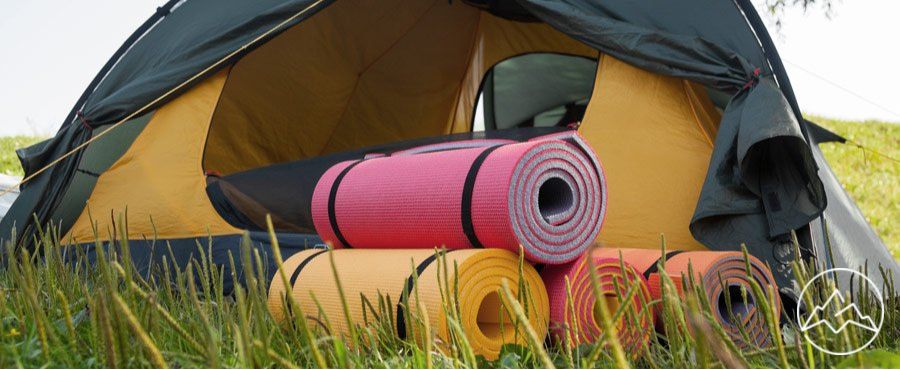Many campers are unaware that sleeping pads are essential to staying warm at night. That sudden chill you feel in your sleeping bag when you wake up in the middle of the night at camp is not because the product is faulty—the bottom of your sleeping bag loses its insulating power after you lay on it for a time.
Choosing the right camping sleeping pads is just as important as picking out your sleeping bag or tent. Keep reading for the definitive guide to the different types of sleeping pads available, features to look for, and how to pick the right pad for your sleep needs.The 3 kinds of sleeping pads
There are three different types of sleeping pad camping products you can choose from. These include:
- Self-inflating pads
- Air pads
- Foam pads
Let’s take a closer look at each variety to help you determine which is right for you.
Self-inflating pads
Self-inflating pads are a highly durable camping pad option, and you can purchase them in a wide range of specifications, including varying insulations, widths, and thickness.
As a rule of thumb, the more thickness a pad features, the more comfortable and warm it will be. However, thicker pads also take up more room and will be bulkier to bring on the road. Self-inflating pads inflate partially, but they’ll need 5 to 15 breaths of air to inflate completely.
Deflating these types of camping sleeping pads can take a minute, because you have to release part of the air by opening the valve, then let the rest out by rolling the pad up and pushing out the air. (Thicker options here effectively cross over to being air mattresses.)
Air pads
Air pads offer the best combination of warmth and weight factors, as a super light pad for four-season use can weigh under 2 pounds total and packs up very compactly. As such, air pads are the camping pad of choice for many outdoor enthusiasts. Air pads are very comfortable, easy to inflate and deflate, offering sufficient thickness, and plenty of warmth.
Foam pads
The main advantage that foam pads have is the fact that they don’t leak. If you prefer minimalist backpacking, foam camping pads could be for you. Foam pads are not as widely popular as they once were, because they are not as warm as the other varieties and the cushioning is thinner.
Also, foam pads are a bit bulky for how thin they are. The choice is up to you, but unless you’re really focused on ultralight backpacking, you’ll probably prefer a self-inflating pad or air pad.
Important features to look for
These are the key features you need to look for if you want to bring a sleeping pad camping.
1. Usage
Some of the key features you’ll want in your sleeping pad will depend on your intended usage needs. Pick your pad based on the type of camping you intend to do. For instance, if you’ll be car camping, it probably won’t be an issue to select a bulkier, thicker model.
Likewise, if you like to keep things as minimalist as possible when you’re on the road, you’ll want to focus on portability, packability, compactness, and a lightweight design first and foremost.
2. Insulation
Consider the insulating qualities of the product when hunting for your camping pad. The R-value of a pad is one of the most critical features of all, indicating the product’s ability to resist heat and revealing how much warmth the pad offers when you sleep on it.
The higher a product’s R-value, the warmer and more insulating it will be. Pick your pad based on the lowest temperature you anticipate you will encounter on your camping trip. For instance, if you’ll be backpacking in winter conditions, you’ll want a pad with a higher R-value than you would for a warm-weather camping trip.
Most camping pads feature R-values ranging between 1 and 10. For three-season camping, pads rated between a 2 and 5 will serve your needs aptly.
3. Inflation and comfort
Another component you’ll want to consider when hunting for the right pad is any inflation that will be required and how comfortable the product really is. The majority of foam pads provide the same comfort and cushioning, though most aren’t over an inch in thickness.
You won’t need to inflate closed-cell foam pads. Inflatable pads come in both self-inflating and manual-inflation varieties. The more air volume a pad will support, the more cushioned the product is going to be.
The pad’s air chamber design also contributes to cushioning, because some products include one air chamber while others have multiple. If you opt for an inflatable pad, you’ll have the bonus of being able to increase or lower the air inside to fit your ideal comfort point.
4. Weight
Weight is a significant component to consider as well. If you tend to be more of an ultralight backpacker, you’ll probably prefer the light design of closed-cell foam pads. The problem is, these aren’t very compact.
For the best of both worlds, an inflatable pad could weigh as little as 1 pound and pack down to less than the size of a 1-liter bottle.
5. Size and shape
Naturally, the pad needs to be spacious enough that you can fit on it. Most standard-sized models are 6 feet long, but many brands sell Long or XL products that are 6 ½ feet in length. The industry standard for width is 20 inches. You could also pick a short model, which is usually only 4 feet long and will support everything except for your legs (this helps keep the packed size way down.)
Pads for camping either feature a mummy or rectangular shape. Mummy pads are larger at the top and narrow closer to your legs and feet. If you don’t move much when you sleep, you might prefer the mummy option. The rectangular pads give you more of a surface to sleep on, which is great if you toss and turn a lot during the night.
Some manufacturers also sell two-person pads, but they are significantly heavier and larger than the regular variety. This may not seem like a big deal – but when you’re going for a multi-day camp, you’re going to want the lightest option you can use since it’s way more packable.
6. Denier and design
You need to take into account the product’s denier rating when hunting for a sleeping pad, which indicates how thick the material’s fibers are. Higher denier ratings translate to thicker and more durable materials. The best pads should have a 30 to 70 denier rating.
The majority of pads are designed from nylon or polyester, but the latter typically features a lower denier rating. However, polyester is thicker and tends to offer more longevity of use than nylon does. Look for pads that come with ripstop nylon, which makes the product resistant to wear and tears.
How to pick the best sleeping pad for your needs
Picking the right pad for your sleep needs doesn’t have to be a challenge. Consider your intended use, such as whether you will be car camping or backpacking. If you are car camping, you can afford to have a thicker sleeping pad that takes up more room. Think about how large your tent is. How much space can you give up to fit the pad inside the structure with ease?
If you are backpacking, a long-range hiker, or a minimalist camper, you’ll want a very lightweight model that has good insulation, and cushioning, and will fold completely. Also, think about your style of sleeping. You might need more cushioning if you’re a side sleeper than if you are a strict stomach sleeper – the right pad for your sleep position can make all the difference in a good night’s sleep. Consider the terrain and weather you’ll encounter on your trip. For rougher terrain, you’ll want a pad with a high-denier and ripstop design. For colder weather winter camping, a pad with a high R-value (temperature rating)is a must as they’re going to be the warmest. Ultimately, the right pad for you is the one that fulfills your personal sleep and camping needs.



